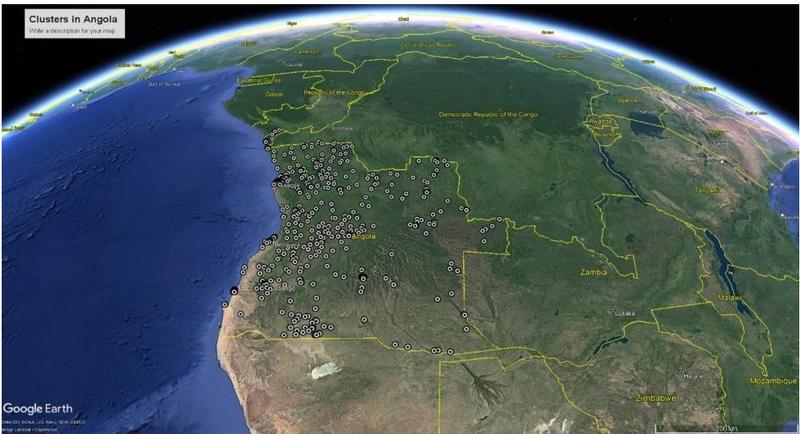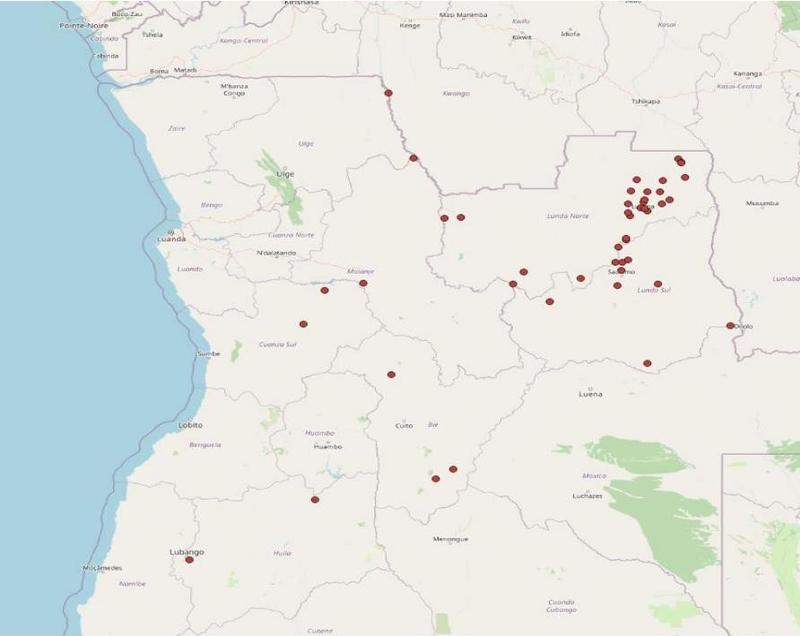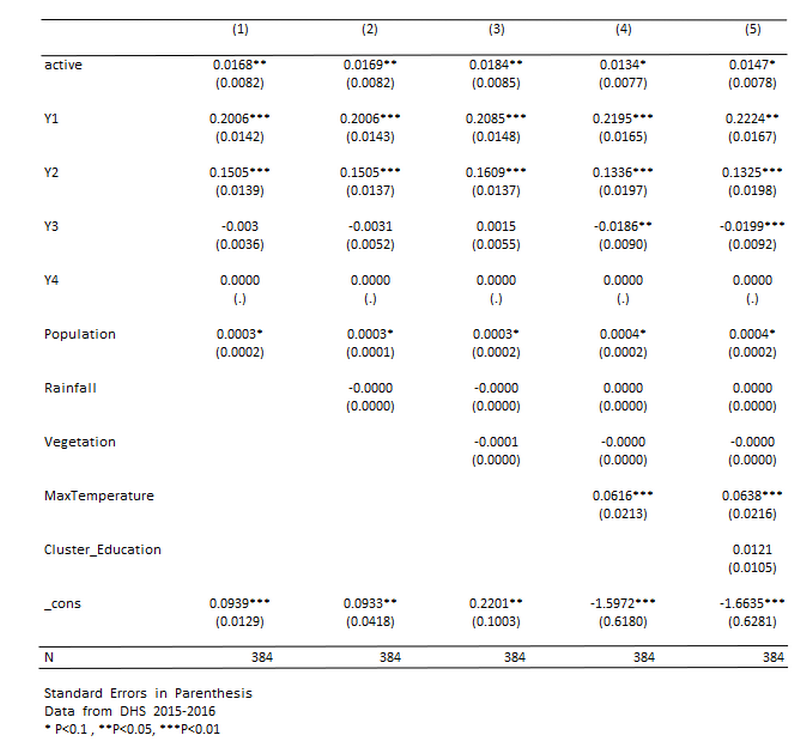Mining and the Incidence of Malaria in Angola and Ghana
How to cite this publication:
Stefanos Papalysandrou (2023). Mining and the Incidence of Malaria in Angola and Ghana. Bergen: Chr. Michelsen Institute (CMI Insight 2023:3)
The discovery of natural resources across the African continent has been embraced as a positive and miraculous event, which could bring millions of people out of poverty and enhance the employment and growth levels of the domestic economy. Sachs and Warner (1997) were the first to show empirical evidence of the “resource curse” hypothesis, where they argued that countries rich in mineral resources tend to grow more slowly in the short term than countries without these resources. The literature on the resource curse extensively analyses the impact of the extraction of natural resources on economic growth, corruption, and the environment. Nevertheless, this literature has neglected health issues related to the resource curse. This CMI insight analyses the impact of a mine opening on the incidence of malaria in Angola and Ghana, with a particular focus on Angola. It highlights that policy makers and other stakeholders of developing economies should not blindly embrace the opening of a mine as a panacea to development.
Introduction
The economic gains that countries rich in natural resources enjoy can contribute to and reinforce practices that help to alleviate the incidence of malaria, such as better housing quality and healthcare systems, as well as greater malaria awareness (Castellanos et al., 2016). Combatting the negative consequences of malaria will significantly benefit the health of those in developing economies and contribute to the achievement of sustainable development goals (SDG). Nevertheless, it is a contentious issue whether the discovery of natural resources constitutes a curse or blessing for developing economies, as there is also the possibility that the methods related to extractive industries will lead to an expansion of malaria transmission.
We show that for Angola, the opening of a mine increases the incidence of malaria in clusters of households located within 30 km of mines, with the poorer section of the country suffering the most. The results are robust even after the inclusion of several controls that explain the incidence of malaria, like the cluster’s population and education levels, and when using alternative distance thresholds between mines and clusters. In Angola, we concentrate on 16,197 individuals residing in 627 clusters, whereas our findings using similar data for Ghana (focusing on 11,835 individuals in 427 clusters) suggest that mines could have a negative effect on the incidence of the disease.

Malaria – what we know so far
Many African, Asian, and Latin American countries like Ghana, Colombia, and Papua New Guinea blame mining activities and specifically large extractive multinational companies for the high incidence levels of malaria affecting the mortality and morbidity of their populations (Knoblauch et al. 2014). Malaria has been named as one of the deadliest tropical mosquito-borne parasitic diseases, killing more than half a million people in 2021, with the main victims being citizens of developing countries. Transmission occurs when a mosquito bites an individual who has malaria, which then causes the mosquito itself to become infected with the disease. That infected mosquito, of the genus Anopheles, passes on the malaria to other non-infected individuals by biting them (Knoblauch et al. 2014).
Social, environmental, and geographical characteristics of the location under examination and malaria
Mining activities, and more precisely illegal ones, tend to attract immigrant workers who are actively looking for employment in mines. This movement of labour across borders increases the risk of imported malaria, like in the case of Venezuela, which shares common borders with Guyana, a country that records approximately 20 thousand malaria cases annually (de Aguiar Barros et al., 2022). Moreover, as De Aguiar Barros et al. (2022), argues, the procedures involved during mining constitute significant factors that hamper the attainment of the malaria elimination goal. Examples include the huge quarries the mining companies create, which are left unattended and open. Consequently, those quarries fill with stagnant water, which attracts Anopheles mosquitos in the area (de Aguiar Barros et al., 2022).
The environmental and geographical characteristics of a mine’s location have also been shown to affect the breeding of Anopheles mosquitoes (Castellanos et al., 2016). Such characteristics include the location’s altitude, its daily temperature, the vegetation levels around it, and the weekly rainfall intensity. Furthermore, the awareness and prevention measure the locals in a mining area employ can significantly influence the propagation of the disease.

Information obtained from DHS 2015
Looking at the DHS (Democratic and Health Survey) model questionnaires, one can find a variety of information about men, women, and children residing in clusters close to and further away from active and future mines. Some of the information we came across includes data on the respondent’s age, the highest level of educational attainment, occupation, and more importantly for us malaria-specific questions.
Using the geospatial covariates dataset, we were also capable of obtaining social, environmental, and geographical data about every cluster for the years 2000, 2005, 2010 and 2015. This includes information on the average temperature and population count recorded in each cluster, as well as the number of insecticide-treated nets that households used. Data on the cluster’s vegetation, rainfall levels, and education were also gathered (ICF, 2018).
Box 1 – Information obtained from IntierraRMG (S&P Global)
Information about 71 industrial mines in Angola were collected from S&P Global, covering the following years of interest: 2000, 2005, 2010, and 2015.
The main shareowner of the mine is also stated, where most of the mines have foreign ownership, including Russian and Australian. The opening and the closing dates of mines can be found in the mining dataset; this information will be used to determine which cluster was or is located close to an active mine and when, as we will formally explain below.
The 71 mines are also geocoded with point coordinates (latitude and longitude) and the activity status of the mine is also reported (active or inactive).
Most of the mines in Angola are diamond mines, with iron ore and copper mines being the next most prevalent.
Panel data analysis
Through the above survey, we managed to create a cluster-level panel that compares the clusters observed in the wake of a mine opening, with the counterfactual scenario, including clusters experiencing a mine opening, but later in the future. Linking the resource data (S&P Global) to the survey data (DHS), we can answer the question under investigation: how the opening of a mine affects the incidence of malaria in Angola. Individuals located within a maximum radius of 30 km away from a mine are assumed to be actively seeking employment, and their involvement with mining activities translates into higher wages and sponsorships from mining companies.
30 km distance threshold
Clusters of households were considered exposed to mining activities if they were located within 30 km of a mining concession. This distance threshold takes into consideration the number of maximum kilometers that Anopheles blood-fed mosquitos can travel, the non-residential lands that are near the mining concessions, and the random spatial offset implemented by the DHS (Mitchell et al, 2022; Lordemus, 2022). We assume that there is little economic footprint beyond 30 km, which is something we further investigate in our robustness checks, where we examine different distance thresholds (e.g. 50 km).
This distance threshold takes into consideration the number of maximum kilometers that Anopheles mosquitos can travel and the number of kilometers that malaria constitutes a risk for a given cluster (Mitchell et al, 2022; Lordemus, 2022). Additionally, the 30 km threshold takes into consideration the boundaries and non-residential lands that are near the mining concessions, and the random spatial offset implemented by the DHS.
Methodology
To examine the relationship between the incidence of malaria and the opening of a mine, we used an entity and time fixed effects model, as shown in equation 1:

Where the outcome Y, in our case the incidence of malaria, in cluster i on the year t, is regressed on cluster and year fixed effects. The dummy variable “active” takes the value 1 if such a cluster experienced a mine opening taking place before the year of Malaria incidence, which we are regressing against.
Time year dummies are also included for the 4 years of interest (2000, 2005, 2010 and 2015) to control variables that are constant across entities but vary over time. Examples include governance and international agreements like grants given by the UNDP to fight HIV and malaria in Angola, in the year 2011. Additionally, the cluster control variables (vector X) combat for any potential exogeneity and capture variables like rainfall, maximum temperature, vegetation, population, and education. As explained above, for such variables we had information for every cluster, for the years 2000 to 2015.
Findings
We conclude that the incidence of Malaria in Angola increases in the wake of a mining boom (Table 1). Even after the inclusion of all the prementioned control variables, hence reaching Column 5, the effect is positive and statistically significant. For every mine opening in Angola, we would expect an associated increase of 0.0147 individuals per year showing clinical symptoms of malaria within the specified buffer zones (2 km for urban, 10 km for rural) around the DHS survey cluster location. This implies that the effect is relatively small in absolute terms. However, the significance of this effect may vary depending on the specific context and public health priorities in Angola.
The control variable population is positive and significant, as the greater the number of people residing in a cluster, the higher the chances of contracting the disease. The variable maximum temperature recorded a positive and significant sign, indicating that Anopheles mosquitoes in Angola thrive in hot weather conditions. The sign for vegetation is negative and mildly significant. Overall, the relationship between vegetation and malaria is a complex one, as this can be affected by multiple factors including the type of vegetation and its density.

Table 1: Angola (30 km) – Fixed Effects Regression using Time Dummies

Robustness checks
To examine whether heterogeneity exists amongst the 627 households interviewed, we will use the variable wealth, that symbolizes the economic status of each household in Angola. More precisely we investigate whether the variable wealth explains the relationship between malaria and mining by including in our fixed effects model an interaction term between our main variable of interest and the variable wealth. The resulting regression is the following:

We are curious to investigate in levels the impact of wealth on the relationship between the incidence of malaria with the opening of a mine. The results confirm that in Angola (Figure 3), the opening of a mine induces an expansion of the incidence of malaria. Nevertheless, this effect does not hold true for all types of households. More precisely, the increased disease burden seems to fall on the poor, as the wealthier groups experience a reduction in malaria when mines open in Angola. An assumption is that when the individual is rich enough, he/she can afford to spend a sufficient share of the income earned through mining on malaria-prevention methods, hence decreasing the prevalence of the disease.
Mining and Ghana
Ghana is the second-largest producer of gold in Africa and an important exporter of gold in the global markets (ChuhanPole et al., 2015). The gold mining industry is one of the most important sectors of the Ghanaian economy, and thus its exploration constitutes an area of interest. Our findings show that the above bad outcomes for Angola are not inevitable, since for Ghana, the relationship between mining and malaria is negative but insignificant and small. Similarly, despite the wealth level of a household, the opening of a mine always induces a reduction of the incidence of the disease. We assume that the difference in results between Angola and Ghana can be explained by the different stages of the countries’ development and more advanced/trustworthy institutions for collecting data in Ghana. Nevertheless, this is something that future empirical research on the resource curse should aim to examine.
Conclusion
The discovery of natural resources in Angola and Ghana could be a source of hope for the millions of people who live under conditions of poverty and who cannot meet their basic needs. However, the extent to which the discovery of natural resources constitutes a curse or a blessing for these economies is still subject to debate. In this study, survey data obtained from the Democratic and Health Survey Program was merged with mineral data from the S&P global to examine how the incidence of malaria in Angola and Ghana is affected after the opening of a new mine. To achieve that, the geolocalisation of both the clusters’ and mines’ latitude and longitude data gathered through the aforementioned sources of data was essential, utilizing applications like Google Earth Pro and (QGIS).
Using coding in Stata, we identified the households residing in clusters located close to active mines, and we examined how the level of malaria in such clusters changes throughout the years 2000 through 2015. Using a fixed effects model with time dummies and control variables, our results suggest how the opening of a new mine constitutes a mixed blessing for developing economies. On the one hand, for Angola, the opening of a new mine seems to increase the level of malaria in clusters residing close to it; whereas on the other hand, for Ghana, the opening of a new mine has a decreasing effect. Consequently, policy makers of developing economies should not blindly embrace the opening of a mine as a panacea to the development issues of their countries, and they should also consider other methods of supporting the economy and alleviating poverty.
Future research
This CMI study can be a good basis for future research investigating the relationship between extractive industries and other diseases like HIV. An avenue for future research would be that of replicating the analysis on a larger sample of sub-Saharan African countries, and then exploring a greater number of observations than those we used in our study. Future analysis should also pay attention to the migration levels of miners taking place between clusters as well as the countries’ development levels and repeat the same experiment while also considering the mine’s annual production levels.
References
Castellanos, A. et al. (2016) “Malaria in gold-mining areas in Colombia,” Memórias do Instituto Oswaldo Cruz, 111(1), pp. 59–66
Chuhan-Pole, P. et al. (2015) “The local socioeconomic effects of gold mining: Evidence from Ghana,” Policy Research Working Papers, pp. 1–20.
De Aguiar Barros, J. et al. (2022) “Gold miners augment malaria transmission in indigenous territories of Roraima State, Brazil,” Malaria Journal, 21(1), pp. 1–10.
ICF (2018) “Demographic and Health Surveys Standard Recode Manual for DHS7,” The Demographic and Health Surveys Program, pp. 20–25.
Knoblauch AM, Winkler MS, Archer C, Divall MJ, Owuor M, Yapo RM, Yao PA, Utzinger J 2014. The epidemiology of malaria and anaemia in the Bonikro mining area, central Côte d’Ivoire. Malar J 13: 194-203
Lordemus, S. (2022) “Does aid for malaria increase with exposure to malaria risk? evidence from mining sites in the d.r.congo*,” Oxford Bulletin of Economics and Statistics, 84(4), pp. 719–731.
Mitchell, C.L. et al. (2022) “Impact of extractive industries on malaria prevalence in the Democratic
Republic of the Congo: A population-based cross-sectional study,” Scientific Reports, 12(1), pp. 1–7.
Acknowledgements
This CMI Insight builds on the Erasmus Mundus Master’s Degree in Economics of Globalization and European Integration Mining and the Incidence of Malaria in Angola. Blessing or Curse?, from the academic year 2022-2023, by Stefanos Papalysandrou.
The author gratefully acknowledges the support provided by his advisors Arne Wiig (CMI) and Ivar Kolstad (NHH/CMI), and the online platform he was given access to, for this master thesis to come true.




